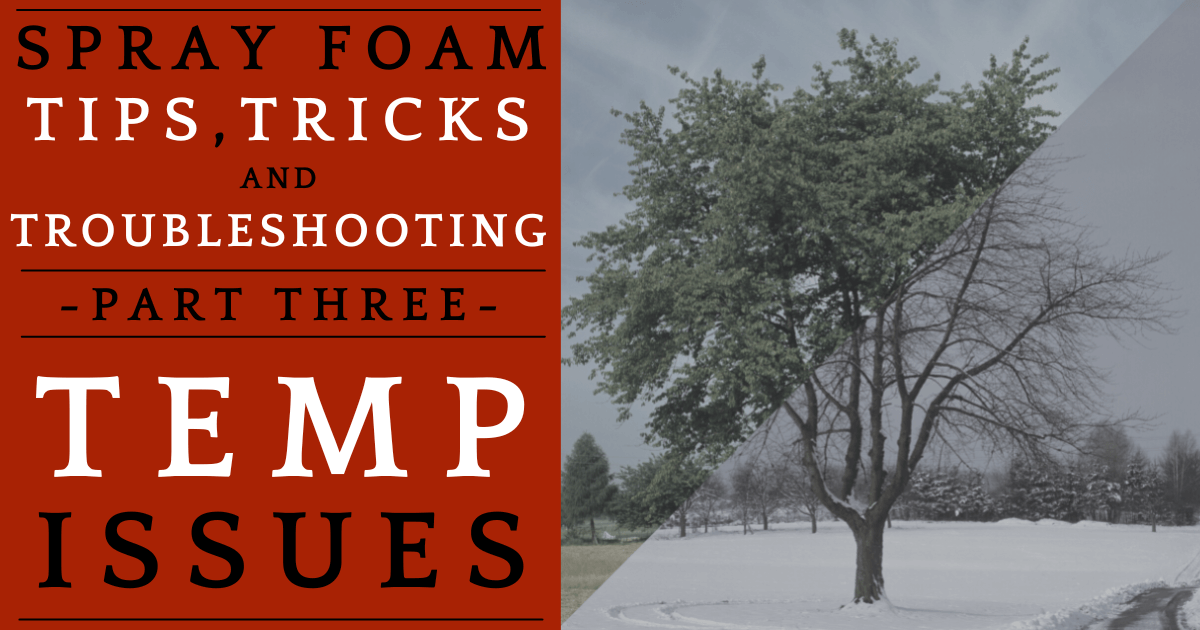Spray Foam Tips, Tricks, and Troubleshooting, Part 3: Diagnosing Heat Management Issues
One of the most vital skills a spray foam contractor can learn is how to diagnose spray foam issues.
Knowing the difference between foam issues – and how to fix them – comes with experience.
Are you new to spraying foam? Has something gone wrong with your foam? Are you feeling frazzled and lost?
Don’t panic!
Here’s a big, fat secret: everyone has to learn to spray foam. No one is born with that knowledge (even those who act like it).
Oh wait…that’s not a secret!
All the bigwigs started exactly where you are. So stop beating yourself up if you don’t know what’s wrong with misbehaving foam!
Freedom Foam & Equipment is here to help you figure out the problem so you can get back to spraying.
There are several commonly-occurring spray foam issues you may encounter while on the job, many of which are preventable. Luckily for you, we lay them all out in our 3-part Spray Foam Tips, Tricks & Troubleshooting blog post!
In Part One, we discussed preventative measures you can take to drastically reduce spray foam issues.
In Part Two, we examined how to diagnose color, texture, and pressure-related problems.
And in this third and final post, we will take a deep dive into recognizing temperature-related issues with your spray foam.
Let’s get started!
Spray Foam Heat Requirements
Proper heat management on the job can help your foam perform at its best.
So which temperature settings will lead to maximum yield and performance for the foam you’re spraying?
Well, every foam blend has different heat requirements.
One brand of foam might perform optimally at a higher temperature than another, so it’s a good idea to ask your spray foam supplier/manufacturer for temperature guidelines before spraying their foam.
Temperature specs for your brand and blend of foam are a great place to start.
That being said, spray foam has a mind of its own sometimes. (Just like spray foamers, right!? Ha!)
Don’t be afraid to adjust your heat settings if your spray foam is indicating a temperature issue.
But we’re getting ahead of ourselves here.
If you find your foam is acting strangely – STOP SPRAYING!
If you don’t stop spraying, you can cause serious harm to your spray foam setup.
Spray foam issues do not fix themselves.
So.
As SOON as you notice an issue with your foam’s behavior, stop spraying so you can figure out what is going on with your system.
Good.
Now, what made you stop spraying?
Take a look at that weird-looking foam…what looks strange about it?
Is the foam expanding too quickly or too slowly?
Is it peeling off the wall?
Is the stream of your spray foam gun creating weird patterns?
If you see any of these issues, system heat management or environmental temperatures may be to blame.
Spray Foam Temperature Issues & Their Indicators
Spray foam, like Goldilocks, likes its temperature to be “just right.”
Not too hot.
Not too cold.
Only the perfect temperature will do. (Whiny stuff, isn’t it!? Sigh.)
The “Goldilocks zone” for each blend of spray foam is slightly different, though – and environmental factors play a role, too, even if you’ve set your preheaters and hose heat to the manufacturer-recommended temperature.
So how do you know something is up with your foam heat?
If you see problems with spray foam expansion or setting/curing, or you notice abnormal flow from your spray gun, you likely have issues with your foam heat. Let’s take a closer look at each of these areas.
Expansion & Setting Issues
Expansion and setting issues often indicate a temperature problem.
Each spray foam blend is ideally sprayed at a specific heat setting and in a specific environmental temperature.
If your foam is too hot, it will expand too quickly or over-expand. It may even start peeling off of the wall after forming.
If your foam is too cold, the expansion will occur too slowly or never reach the desired expansion.
Keep in mind that substrate heat and environmental temperatures also play a role in how well spray foam performs.
If you notice expansion issues, adjust your preheater, hose, or environmental temperatures as necessary.
Another indicator of a temperature-related issue is the stream and spray pattern coming from your spray gun.
Spray Foam Stream Issues
Spraying good foam requires paying attention.
You know good foam when you see it, right? It’s so purdy!
You’ll also know if the foam doesn’t look right – if you’re paying attention.
One of the easiest things to watch when spraying foam is the stream of the foam coming out of the spray foam gun.
Has your foam stream started to separate – or “finger out” – as you spray? That is likely an indicator that your spray foam material is too hot.
Is your nice, circular spray foam pattern narrowing or concentrating into a single stream – even having difficulty coming out of the spray gun? Your foam may be too cold.
You may be tempted to just keep spraying when you notice a temperature-related issue – don’t. You can save a LOT of time and money if you address the issues you see with your foam.
For one thing, cold foam doesn’t cover as many board feet as warm foam, so if you notice your coverage decreasing, it’s time to check the temperature settings on your spray foam machine and make any needed adjustments.
Higher board coverage means more profit for you. See why paying attention to your foam is important?
We thought you would!
If you’ve tried everything you can think of and you’re still stumped about what is wrong with your spray foam, give us a call!
We will be happy to help you figure out what is going on.
Conclusion
Spray foam is a fantastic feat of science.
But it can be fickle, too.
Paying attention to the foam you spray can save you time and money down the road – not to mention headaches!
Expansion and setting issues and an abnormal foam stream from your spray gun are indicators that something is up with your spray foam temperatures.
If you’re noticing strange colors or textures with your foam, check out Part 2 of this blog post for help.
If you need assistance diagnosing the issues you see with your foam, give us a call! We are here for you, no matter your experience level.
Until next time, all the best in your spray foam journey!








One Comment
Comments are closed.